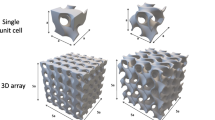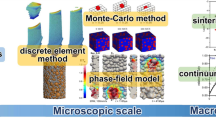Abstract
Extrudate swell is a rheological phenomenon of polymers that occurs after the extrusion die exit due to relaxation of the residual molecular stress. This phenomenon is essential to ensure the accuracy and stability of components manufactured by Extrusion-based additive manufacturing (EAM) process. Extrudate swell can be affected by multiple factors including material properties and processing parameters that can be coupled and it is difficult to fully understand their effects, especially in absence of accurate online measurement devices. In this study, the extrudate swell was investigated experimentally as a function of the extrusion rate, melt temperature and nozzle diameter for polylactic acid (PLA) material. The Computational fluid dynamics (CFD) and level set method (LS) in COMSOL Multiphysics were used to simulate the polymer flow out of the extrusion nozzle. The simulation results matched well with experimental results and showed that the swell rate decreases with increasing temperature and nozzle diameter and decreasing extrusion rate. These results can be used to optimize the parameters of EAM processes.













Similar content being viewed by others
References
Rane K, Strano M (2019) A comprehensive review of extrusion-based additive manufacturing processes for rapid production of metallic and ceramic parts. Adv Manuf 7:155–173. https://doi.org/10.1007/s40436-019-00253-6
Strano M, Rane K, Farid MA et al (2021) Extrusion-based additive manufacturing of forming and molding tools. Int J Adv Manuf Technol 117:2059–2071. https://doi.org/10.1007/s00170-021-07162-8
Van den Eynde M, Van Puyvelde P (2018) 3D printing of poly (lactic acid). In: Di Lorenzo ML, Androsch R (eds) Industrial Applications of Poly(lactic acid). Springer, Cham, pp 139–158
Wickramasinghe S, Do T, Tran P (2020) FDM-based 3D printing of polymer and associated composite: a review on mechanical properties, defects and treatments. Polymers (Basel) 12(7):1529. https://doi.org/10.3390/polym12071529
Charpentier N, Barrière T, Bernard F, Boudeau N, Gilbin A, Vikner P (2022) PIM-like EAM of steel-tool alloy via bio-based polymer. Procedia CIRP 108:477–482. https://doi.org/10.1016/j.procir.2022.04.077
Hassan W, Farid MA, Tosi A, Rane K, Strano M (2021) The effect of printing parameters on sintered properties of extrusion-based additively manufactured stainless steel 316L parts. Int J Adv Manuf Technol 114:3057–3067. https://doi.org/10.1007/s00170-021-07047-w
Gonzalez−Gutierrez J, Cano S, Schuschnigg S et al (2018) Additive manufacturing of metallic and ceramic components by the material extrusion of highly-filled polymers: a review and future perspectives. Materials (Basel) 11:840. https://doi.org/10.3390/ma11050840
Sinthavathavorn W, Nithitanakul M, Grady BP, Magaraphan R (2009) Melt rheology and die swell of PA6/LDPE blends by using lithium ionomer as a compatibilizer. Polym Bull 63:23–35. https://doi.org/10.1007/s00289-009-0063-x
Liang JZ, Yang J, Tang CY (2010) Die-swell behavior of PP/Al(OH)3/Mg(OH)2 flame retardant composite melts. Polym Test 29:624–628. https://doi.org/10.1016/j.polymertesting.2010.03.014
Anand JS, Bhardwaj IS (1980) Die swell behaviour of polypropylene ? an experimental investigation. Rheol Acta 19:614–622. https://doi.org/10.1007/BF01517515
Behzadfar E, Ansari M, Konaganti VK, Hatzikiriakos SG (2015) Extrudate swell of HDPE melts: I. Experimental. J Nonnewton Fluid Mech 225:86–93. https://doi.org/10.1016/j.jnnfm.2015.07.008
Utracki LA, Bakerdjian Z, Kamal MR (1975) A method for the measurement of the true die swell of polymer melts. J Appl Polym Sci 19:481–501. https://doi.org/10.1002/app.1975.070190213
Dutta A, Ryan ME (1982) A study of parison development in extrusion blow molding. J Nonnewton Fluid Mech 10:235–256. https://doi.org/10.1016/0377-0257(82)80003-7
Kalyon D, Tan V, Kamal MR (1980) The dynamics of parison development in blow molding. Polym Eng Sci 20:773–777. https://doi.org/10.1002/pen.760201202
Béreaux Y, Charmeau J-Y, Balcaen J (2012) Optical measurement and modelling of parison sag and swell in blow moulding. Int J Mater Form 5:199–211. https://doi.org/10.1007/s12289-011-1040-0
Tang D, Marchesini FH, D’hooge DR, Cardon L (2019) Isothermal flow of neat polypropylene through a slit die and its die swell: bridging experiments and 3D numerical simulations. J Nonnewton Fluid Mech 266:33–45. https://doi.org/10.1016/j.jnnfm.2019.02.004
Tanner RI (1970) A theory of die-swell. J Polym Sci Part A-2 Polym Phys 8:2067–2078. https://doi.org/10.1002/pol.1970.160081203
Tang D, Marchesini FH, Cardon L, D’hooge DR (2019) Three-dimensional flow simulations for polymer extrudate swell out of slit dies from low to high aspect ratios. Phys Fluids 31:093103. https://doi.org/10.1063/1.5116850
Konaganti VK, Ansari M, Mitsoulis E, Hatzikiriakos SG (2015) Extrudate swell of a high-density polyethylene melt: II. Modeling using integral and differential constitutive equations. J Nonnewton Fluid Mech 225:94–105. https://doi.org/10.1016/j.jnnfm.2015.07.005
Grzybowski H, Mosdorf R (2014) Modelling of two-phase flow in a minichannel using level-set method. J Phys Conf Ser 530:012049. https://doi.org/10.1088/1742-6596/530/1/012049
Tümer EH, Erbil HY (2021) Extrusion-based 3D printing applications of PLA composites: a review. Coatings 11:390. https://doi.org/10.3390/coatings11040390
Zhong Y, Fang H, Zhang Y et al (2013) Rheologically determined critical shear rates for shear-induced nucleation rate enhancements of poly(lactic acid). ACS Sustain Chem Eng 1:663–672. https://doi.org/10.1021/sc400040b
Dervieux A, Thomasset F (1980) A finite element method for the simulation of a Rayleigh-Taylor instability. Approximation Methods for Navier-Stokes Problems. Springer, Berlin, Heidelberg, pp 145–158
Osher S, Fedkiw R, Piechor K (2004) Level set methods and dynamic implicit surfaces. Appl Mech Rev 57:B15–B15. https://doi.org/10.1115/1.1760520
Sethian JA (1999) Level set methods and fast marching methods: evolving interfaces in computational geometry, fluid mechanics, computer vision, and materials science. Cambridge University Press
Kazmer DO, Colon AR, Peterson AM, Kim SK (2021) Concurrent characterization of compressibility and viscosity in extrusion-based additive manufacturing of acrylonitrile butadiene styrene with fault diagnoses. Addit Manuf 46:102106. https://doi.org/10.1016/j.addma.2021.102106
Hyvärinen M, Jabeen R, Kärki T (2020) The modelling of extrusion processes for polymers—a review. Polymers (Basel) 12:1306. https://doi.org/10.3390/polym12061306
Anderegg DA, Bryant HA, Ruffin DC et al (2019) In-situ monitoring of polymer flow temperature and pressure in extrusion based additive manufacturing. Addit Manuf 26:76–83. https://doi.org/10.1016/j.addma.2019.01.002
Serdeczny MP, Comminal R, Pedersen DB, Spangenberg J (2020) Experimental and analytical study of the polymer melt flow through the hot-end in material extrusion additive manufacturing. Addit Manuf 32:100997. https://doi.org/10.1016/j.addma.2019.100997
Tanner RI (2005) A theory of die-swell revisited. J Nonnewton Fluid Mech 129:85–87. https://doi.org/10.1016/j.jnnfm.2005.05.010
Acknowledgements
The authors gratefully acknowledged the financial support received from the China Scholarship Council (CSC). Experimental tests were carried out thanks to SupMicroTech-ENSMM workshop and local plateforms (AMETISTE for metrology and tribology, MIFHYSTO for cutting forces). This work was carried out within the Manufacturing 21 network, which gathers about 20 French research laboratories. The covered topics are the study and modeling of the manufacturing processes, especially the numerical simulation and investigation of extrudate swell of PLA via extrusion-based Additive Manufacturing process.
Author information
Authors and Affiliations
Contributions
H. Wang: design, methodology, data analysis, visualization, writing—original draft.
F. Rabhi: data analysis, writing—editing.
A. Cherouat: supervision, review—editing.
A. Gilbin: methodology.
T. Barriere: supervision, review—editing.
Corresponding author
Ethics declarations
Competing interests
The authors have no competing interests to declare that are relevant to the content of this article. This work was realized on a 3D printing equipment at the Department of Applied Mechanics of Besançon, the presented results are free of commercial rights.
Additional information
Publisher's note
Springer Nature remains neutral with regard to jurisdictional claims in published maps and institutional affiliations.
Rights and permissions
Springer Nature or its licensor (e.g. a society or other partner) holds exclusive rights to this article under a publishing agreement with the author(s) or other rightsholder(s); author self-archiving of the accepted manuscript version of this article is solely governed by the terms of such publishing agreement and applicable law.
About this article
Cite this article
Wang, H., Rabhi, F., Cherouat, A. et al. Experimental and numerical investigation of extrudate swell of polylactic acid via extrusion-based additive manufacturing process. Int J Adv Manuf Technol 131, 663–674 (2024). https://doi.org/10.1007/s00170-023-11493-z
Received:
Accepted:
Published:
Issue Date:
DOI: https://doi.org/10.1007/s00170-023-11493-z




